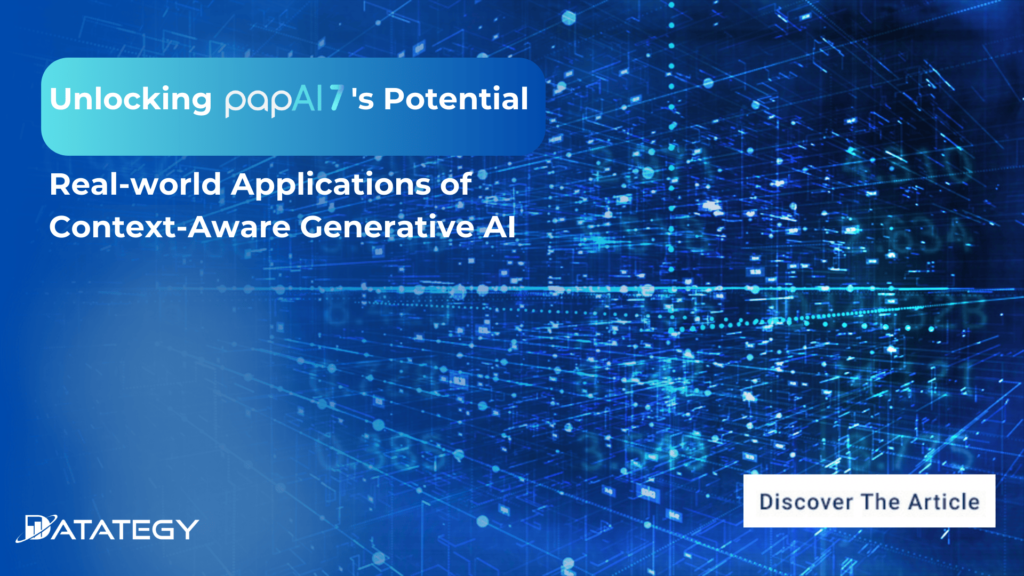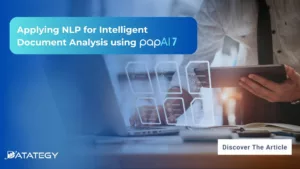Life at Datategy : Enzo DAMION Hello everyone, my name...
Read MoreUnlocking papAI 7's Potential:
Real-world Applications of Context-Aware Generative AI
Table of Contents
ToggleIn today’s rapidly evolving technological landscape, Context-Aware Generative AI stands at the forefront of innovation, reshaping how we interact with machines and data. Although there are many different types of AI technology, generative AI that can produce human-like content is currently making all the headlines. The popularity of ChatGPT has inspired hundreds of new startups and a competitive marketplace worth $3.7 billion by the end of the year (Source: S&P Global).

In this article, we look at the real impact and practical benefits of this technology in a number of areas.
Understanding Context-Aware Generative AI
Prior to moving on to practical applications, let’s understand the principles. The theory behind “Context-Aware Generative AI” is that an AI system may create content while also comprehending and adjusting to its environment. It is an artificial intelligence approach that closes the gap between the processing of unstructured data and understanding that is on par with human ability. Imagine an AI system that, in addition to producing text, graphics, or responses, also takes into account the who, what, where, when, and why—the fundamental context-related questions.
On the most recent iteration of papAI, for example, the user may select the length of the text to automatically construct product descriptions. By applying this standard, the user may produce a description that is suitable for his online shop, social media platforms, and internal brochures while still taking into account the latter’s constraints.
Generative AI vs. Context-Aware Generative AI
To properly comprehend the significance of context-aware generative AI (CAGA), it is essential to distinguish it from traditional generative AI. While generative AI transformed content creation by automatically creating content based on pre-established patterns, (CAGA) improves this notion by including customization and flexibility into the equation.
| Aspect | Generative AI | Context-Aware Generative AI |
|---|---|---|
| Flexibility | Operates within fixed models | Adaptable to user-defined criteria |
| Content Creation | Generates content based on patterns | Creates content tailored to specific needs |
| Parameters | Fixed set of rules and models | Parameters defined by users for content generation |
| Adaptability | Limited adaptability | High degree of adaptability and customization |
| Content Variety | Limited range of generated content | Wide array of content types and styles |
| Automation | Partial automation | More automated content generation process |
Real-world Applications
Applications for Context-Aware Generative AI cover a variety of sectors and are still expanding: Here, several significant Innovative application cases are covered:
1- Text Generation
Language models, like GPT-3, have shown a remarkable capacity to produce text that is coherent and contextually relevant, ushering in important developments across a wide range of fields. The usage of these models has significantly improved chatbot functioning and allowed for more believable and human-like user interactions. Additionally, language models simplify the process of creating high-quality written material for a variety of purposes, from journalism to marketing. By examining user data and preferences and providing specialized recommendations in domains like e-commerce, entertainment, and information retrieval, they also enable personalized recommendations. Language models’ revolutionary influence is still reshaping communication and content development paradigms in a variety of sectors.
2- Audio and Music Generation
The creation of video games, movies, and music have all benefited greatly from generative AI models’ outstanding talent for creating sound effects and songs. These cutting-edge models are capable of creating unique, moving sounds, boosting the creative process, and providing composers and artists with fresh compositions. Context-aware generative AI makes it possible to quickly create custom sound effects in the world of filmmaking, enabling fascinating and immersive cinematic experiences. The creation of interactive and dynamic audio features by video game creators also makes use of this technology, enhancing gameplay and narrative storytelling. In a wide range of media sectors, generative AI’s significant influence on audio production is continuing to transform artistic expression and enjoyment.
3- Code Generation
Code generation tools like Python script generators and Java program generators can be employed. This may be used to automate processes like creating documentation or building unit tests. A neural network is often trained on a huge dataset of code samples throughout the code creation process. The neural network picks up on the patterns and structures of the code, which it may then use to create new code that is similar to the samples it was trained on in terms of both structure and functionality. There are several applications for code creation. Automating the creation of unit tests is one frequent use case. Small bits of code known as unit tests are used to test certain functional components within software programs. They may be applied to find problems and check that the program is operating properly. Unit tests for a software program may be generated automatically using CAGA, which can save developers a lot of work.
4- Product Design
By automating the creation and evaluation of design concepts, Context-aware generative AI may be applied to the design of new goods. By cutting the time and expense required to make prototypes, this can aid in increasing the effectiveness of the product design process. Looking at a larger variety of design options can also assist in producing more unique items. Here are a few particular applications of generative AI in product design:
Design concept generation: Generative AI can learn from a dataset of current items to produce design concepts. This may be accomplished by using a dataset of photos or product CAD models to train a neural network. The neural network may then be used to provide fresh design ideas that are functionally and aesthetically comparable to the dataset’s sampled goods.
Generative AI may also be used to assess design concepts by modeling how well they work under real-world circumstances. This may be accomplished by either utilizing physical prototypes to evaluate the product’s performance or by using computer simulations to forecast how the product will operate. The outcomes of these experiments or simulations can subsequently be utilized to enhance the product’s design.
5- Customer Service
Chatbots that can assist customers or respond to their inquiries can be developed using generative AI. By doing this, firms may increase customer satisfaction while cutting back on customer service expenses. Even if a customer’s inquiry is challenging or complicated, chatbots powered by generative AI can provide a prompt and correct response. Additionally, they may offer round-the-clock customer service, which can assist firms in increasing client satisfaction. It’s crucial to remember that chatbots cannot take the role of real people in customer support. To deliver the best possible customer service, it is crucial to have a combination of human and AI agents.
6- Synthetic Data Creation
Using CAGA, it is possible to produce artificial data types including pictures, text, and audio. This may be used to assess the effectiveness of current models or to train machine learning models. Instead of being gathered from the real world, synthetic data is information that has been manufactured artificially. This can be helpful in a variety of circumstances, such as when gathering actual data is expensive or difficult, or when the real data is not indicative of the issue that the machine learning model is attempting to address.
With the use of generative AI, artificial data that resembles actual data in terms of its statistical characteristics may be produced. As a result, machine learning models that will perform well on actual data may be trained using synthetic data. For instance, synthetic pictures of people, objects, or scenes can be produced using generative AI. Machine learning models may be trained using this to do tasks like facial recognition, object identification, or scene interpretation. Synthetic text may also be produced using generative AI. This may be used to train machine learning models for tasks like text production, machine translation, and natural language processing.
Watch papAI7's Demo and Redefine Your Possibilities
An amazing experience is seeing generative AI in action on the updated papAI. The most recent incarnation of papAI, which promises to revolutionise content production by leveraging the power of adaptation and scalability, is innovatively demonstrated in this live presentation.
Increase your productivity by developing your own AI-based generative tool with papAI solution
With papAI solution, you have an opportunity to totally change your content generation strategy. You may design an AI-driven toolset that is especially suited to your needs using our platform. The accuracy and effectiveness of your content production efforts may be increased by utilizing cutting-edge machine-generated learning techniques.
To learn more about how the papAI solution can change your AI landscape, schedule your personalized demo now. Our team of specialists can assist you in developing a special AI-based product that is tailored to the requirements of your company.
Interested in discovering papAI?
Our AI expert team is at your disposal for any questions
Applying NLP for Intelligent Document Analysis using papAI 7
Applying NLP for Intelligent Document Analysis using papAI 7 AI...
Read More“DATATEGY EARLY CAREERS PROGRAM” With Samar CHERNI
“DATATEGY EARLY CAREERS PROGRAM” With Samar CHERNI Hello, my name...
Read MoreAI Origins: Yann LeCun
AI Origins: Yann LeCun Welcome to ”AI Origins “ series....
Read More


